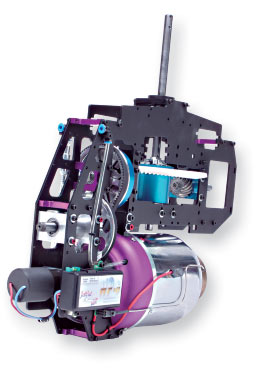I realize that this thread is dead, but just for posterity, a company in Boston, MA, Satcon technology, produced a dual turbo alternator drivetrain for an american le mans car back in 1994. The budget was paid for by Chrysler. The high speed turboalternator I think turned at 100krpm and the low speed at 50krpm. Both of these devices ran on liquid methane for fuel, and were direct coupled devices. They delivered power to an 80lbs carbon fiber flywheel turning at up to 60krpm. The power was then delivered on a demand basis (the gas pedal), to the traction motor, so the flywheel in turn was a high speed alternator. The traction motor was a water a cooled, vector controlled, squirrel cage induction motor running at up to 24kRPM with a torque of 350 ft lbs of torque to 12kRPM, and 150% of that torque at 0RPM. The project budget was originally USD35 million for 3 motors. All of this technology, including the driver circuits and controls were developed and a lot of them were patented by Satcon Technology. They're still around, but I'm not sure if they can still develop this type of tech. The car was deemed not viable due to concerns with the flywheel. In other words, the rest is practical, it's just that if the car crashed, and was turned upside down the flywheel would most likely shatter, the flywheel parts would most likely go through the housing, then through the LNG tank and through the driver.
In terms of efficiency, this car converted chemical energy to mechanical, to electrical (turboalterntors), then to mechanical again (flywheel), then to electrical again (to power the traction motor), then to mechanical again (traction motor) with an efficiency of over 70%. It all depends what components you use and the tolerances you're willing to accept.
From what I remember, the electronics weighed 110lbs (managing 3.5MW), and the traction motor around 150lbs. The turboalternators were tiny, and were probably the lightest part of the bunch.
Here's a link, but don't take what says all it says literally. Satcon had at least 50 engineers working on that project, and every single part in the project required developing new technology. In this article they throw the blame on Satcon, but to this day I'm amazed that the thing even worked (and it did, in the lab):
http://www.allpar.com/model/patriot.html
Here's another link:
http://freepdfhosting.com/d4b2933536.pdf



F~dm*dv,P~dm*dv^2) which is why turbo-props and turbo-fans are used. -- For a quad-rotor the alternatives become mechanical reduction gears, shafts and variable pitch rotors or high-speed alternator + conventional motor/controller. \$\endgroup\$